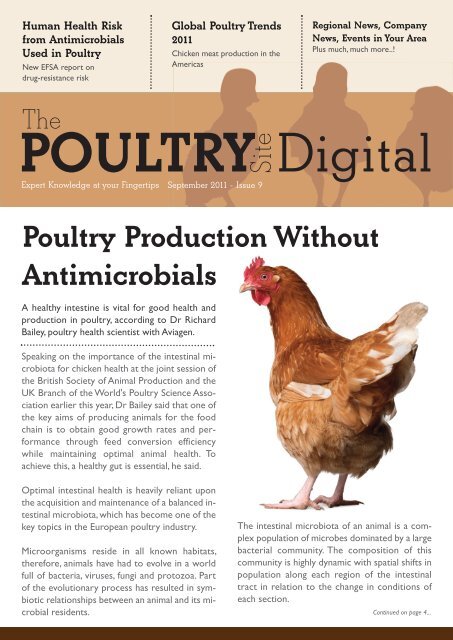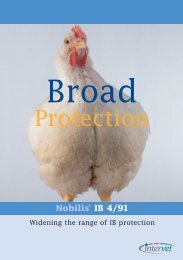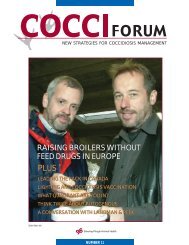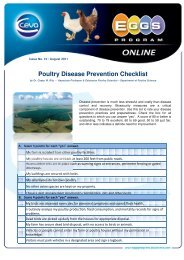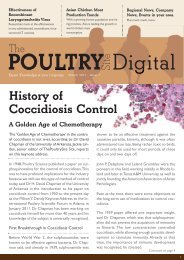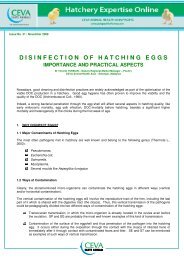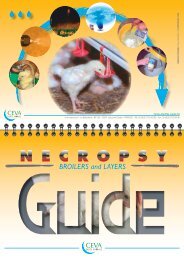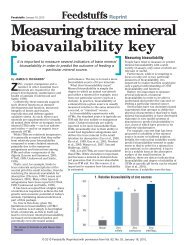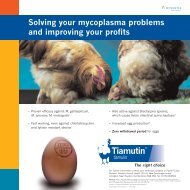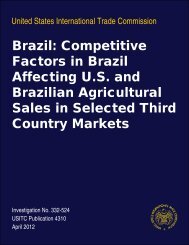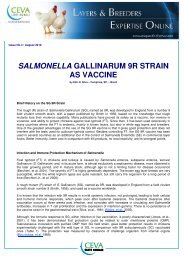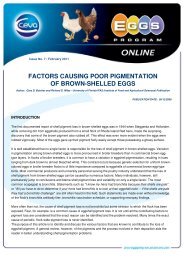Poultry_Digital_9_Layout 1 - The Poultry Site
Poultry_Digital_9_Layout 1 - The Poultry Site
Poultry_Digital_9_Layout 1 - The Poultry Site
- No tags were found...
Create successful ePaper yourself
Turn your PDF publications into a flip-book with our unique Google optimized e-Paper software.
Human Health Riskfrom AntimicrobialsUsed in <strong>Poultry</strong>New EFSA report ondrug-resistance riskGlobal <strong>Poultry</strong> Trends2011Chicken meat production in theAmericasRegional News, CompanyNews, Events in Your AreaPlus much, much more..!<strong>The</strong>POULTRY <strong>Digital</strong><strong>Site</strong>Expert Knowledge at your FingertipsSeptember 2011 - Issue 9<strong>Poultry</strong> Production WithoutAntimicrobialsA healthy intestine is vital for good health andproduction in poultry, according to Dr RichardBailey, poultry health scientist with Aviagen.Speaking on the importance of the intestinal microbiotafor chicken health at the joint session ofthe British Society of Animal Production and theUK Branch of the World's <strong>Poultry</strong> Science Associationearlier this year, Dr Bailey said that one ofthe key aims of producing animals for the foodchain is to obtain good growth rates and performancethrough feed conversion efficiencywhile maintaining optimal animal health. Toachieve this, a healthy gut is essential, he said.Optimal intestinal health is heavily reliant uponthe acquisition and maintenance of a balanced intestinalmicrobiota, which has become one of thekey topics in the European poultry industry.Microorganisms reside in all known habitats,therefore, animals have had to evolve in a worldfull of bacteria, viruses, fungi and protozoa. Partof the evolutionary process has resulted in symbioticrelationships between an animal and its microbialresidents.<strong>The</strong> intestinal microbiota of an animal is a complexpopulation of microbes dominated by a largebacterial community. <strong>The</strong> composition of thiscommunity is highly dynamic with spatial shifts inpopulation along each region of the intestinaltract in relation to the change in conditions ofeach section.Continued on page 4...1
September 2011 - Issue 9Expert Knowledge at your FingertipsScientific Opinion onthe Public Health Risksof Drug-ResistantBacteria<strong>The</strong> use of antimicrobials in foodproducinganimals is a risk to publichealth and it can help to spreadthe bacterial strains, according toan EFSA expert panel. Page 8<strong>Poultry</strong> Production WithoutAntimicrobialsA healthy intestine is vital for good health and production in poultry,according to Dr Richard Bailey, poultry health scientist with Aviagen.Page 1Americas Holds Shareof Global ChickenMeat ProductionMore rapid growth in productionamong the leading South Americancountries will enable theAmericas to maintain its share ofglobal chicken meat output.Page 160314Edito rialA word from the EditorDietary Yeast Extracts Tested as Alternative toAntibiotics in <strong>Poultry</strong>A dietary yeast extract could be an effective alternative to antibiotics for turkey producers, accordingto a US Department of Agriculture (USDA) study.22Regional News<strong>The</strong> latest news from the Americas, Europe, Asia, Africa and OceaniaGet in Touch!26 EventsKeep up to date with what is happening in the global poultry industry.28 Company NewsNews from our advertisersFor Editorial Enquiries:Jackie Lindenjackie.linden@5mpublishing.comTel: +44 (0) 1234 818180For Advertising Enquiries:Alex GuyAlex.guy@5mpublishing.comTel: +44 (0) 1234 8181802
EditorialWelcome to <strong>The</strong><strong>Poultry</strong><strong>Site</strong> <strong>Digital</strong> Issue 9Alternatives toAntibioticsA clear link has now been established betweenthe use of antibiotics in farm livestock and the developmentof drug resistance in some importantbacterial strains in human health.According to a report from the European FoodSafety Authority (EFSA) published a month ago,the use of antimicrobials in food-producing animalsis a risk to public health and can help tospread the drug-resistant bacterial strains.EFSA’s expert panel said it is a priority to limitthe risk to public health that can arise from resistancein the food chain.<strong>The</strong> report adds that that an effective optionwould be to restrict or stop the use ofcephalosporins in the treatment of food-producinganimals.It would be almost impossible to rear poultrycommercially without access to any antimicrobials,at least for the treatment of disease on thegrounds of animal welfare, but the EFSA reporthas provided extra pressure to end their routineuse in the EU.In this issue, there is a summary of the EFSA reportand we also examine some alternatives toantimicrobials.poultry and what can go wrong if the crucial balanceis disturbed. <strong>The</strong> article is based on a paperpresented earlier this year by Dr Richard Bailey,poultry health specialist with Aviagen.<strong>The</strong>re is also an article on work at the USDAAgricultural Research Service on the use of yeastto maintain poultry health without the need forantimicrobial feed additives.And last but by no means least, the new series ofarticles in our exclusive series, Global <strong>Poultry</strong>Trends 2011, starts in this issue with a look at thetrends in broiler production in the Americas byseasoned industry watcher, Terry Evans.Jackie Linden<strong>The</strong><strong>Poultry</strong>site.com Senior Editor<strong>The</strong> lead feature looks at the importance of establishinga healthy gut microbial population in3
Feature Article<strong>Poultry</strong> Production Without AntimicrobialsContinued from front pageWith total bacterial cells numbers outnumberingthe host's own cell number by a ratio of 10 toone, it is not surprising that the intestinal microbiotaplays a vital part in the health and well-beingof all animals, Dr Bailey said.Many mechanisms have been identified by whichthe microbiota promotes host health. It has beenfound that the intestinal microbiota aids digestion,protects against pathogens, produces nutrientsand plays a role in the development and maturationof the immune system.With the advent of culture-independent DNAtechnologies, our knowledge of the compositionof the intestinal microbiota has improved greatly,explained Dr Bailey. Using these techniques, it hasbeen suggested that the intestinal microbiota ofthe chicken comprises around 640 species of bacteriafrom 150 different genera. <strong>The</strong> increased applicationof molecular methods has revealed thatculture-based methods had vastly underestimatedthe complex community of bacteria within an animal'smicrobiota.DGGE microbial profiles as an example ofculture-independent DNA-based microbialprofilingImportance of gut microbiota in health anddiseaseBeneficial effects of intestinal bacteria- Stimulation of host immune system- Aid to digestion- Production of short chain fatty acids andvitamins- Inhibition of pathogenic bacteria- Transformation of bioactive compounds4
It has been demonstrated that the compositionof the intestinal microbiota is affected by factorssuch as sex, age, dietary intake and health statusof the host. <strong>The</strong> exact relationship between thehost and its resident microbiota is still an activearea of research and it is becoming ever more apparentthat the intestinal microbiota is highly influentialin terms of host health and immunity.Culture-independent techniques combined with'-omics' technologies have allowed microbiologiststo learn more about the relationship betweenthe host and its resident microbiota.<strong>The</strong>re is a delicate balance between the host, intestinalmicrobiota, the intestinal environment anddiet, continued Dr Bailey. If there is an imbalancein the relationship, the composition of the intestinalmicrobiota may alter. <strong>The</strong> shift in microbialpopulations can have a negative effect on the host,leading to poor growth and impaired performance.This is seen in cases of dysbacteriosis.Dysbacteriosis is a digestive condition of poultryand has been broadly described as an overgrowthof the intestinal microbiota – especially membersof the Bacteriodetes, Clostridium spp. and E. coli– which can lead to non-specific enteritis. Onsetis usually between 20 and 30 days of age and it isthought to be triggered by changes in diet, poormanagement and overcrowding. <strong>The</strong> conditionrarely causes clinical signs but it can adversely affectbird performance.Typically, dysbacteriosis is treated using antimicrobialtherapy. However, with increasing pressure onveterinarians and poultry producers in manycountries to reduce antibiotic use, there is a needto find alternatives to promote good intestinalhealth and prevent intestinal upsets.<strong>The</strong> management of intestinal health without antimicrobialsis a wide area of research. <strong>The</strong> use ofa probiotic supplement is a popular approach, saidDr Bailey. Probiotics have been found to boostenteric health by inhibiting the growth and/or attachmentof less favourable bacteria in the intestinaltract or by modulating the composition ofthe intestinal microbiota towards a morefavourable community.What happens when there is an imbalance?Possible consequences of an imbalance in theintestinal microbiota- Poor digestion and passage of undigested feed- Poor flock uniformity- Poor feed conversion- Wet litter- Susceptibility to enteric pathogensIntestinal bacteria derive most of their energyfrom the host's diet so poultry feed compositionhas a major influence on bacterial populations andit is possible to modulate the microbiota by alteringthe diet and including specific components,such as essential oils, oligosaccharides (in theform of prebiotics), enzymes and specific carbohydratesources.Deciding on the best approach is not easy as resultsfrom intervention studies can vary. <strong>The</strong> keyto the maintenance of intestinal health is to understandhow the intestinal microbiota changesat key points in the bird's life and how to preparethe bird for these changes.<strong>The</strong> combination of practical field experiencefrom poultry producers and veterinarians withlaboratory research into the relationships betweenthe host and its microbiota is likely to re-5
Feature Article<strong>Poultry</strong> Production Without Antimicrobialsveal further ways by which enteric health can beimproved in future.Summing up, Dr Bailey said that intestinal healthis vital for good overall health and performancein poultry, as in other animals. Disruption of theresident bacteria can have detrimental effects,leading to digestive upsets and a loss in performance.However, he said, there is a mounting bodyof evidence indicating that the intestinal microbiotacan be successfully modulated by the use ofprobiotics, when the appropriate product is administeredcorrectly and at the appropriate time.Research into alternatives to antimicrobials remainsan important area of study.A number of research groups from across theglobe have demonstrated in laboratory trials thatthere is a place for products such as probiotics inhelping to control gut pathogens, thus reducingthe need for antimicrobials. <strong>The</strong>y also have potentialto help establish a healthy gut microbial populationearly in the chick's life and potentiallyprevent intestinal imbalances as the result of commonstressful events, such as feed change, vaccinationor thinning, added Dr Bailey.6
Feature ArticleScientific Opinion on the Public HealthRisks of Drug-Resistant Bacteria<strong>The</strong> use of antimicrobials in food-producing animalsis a risk to public health and it can help tospread the bacterial strains, according to an EFSAexpert panel.Following a request from the European Commission,the Panel on Biological Hazards (BIOHAZ)was asked to deliver a Scientific Opinion on thepublic health risks of bacterial strains producingextended-spectrum beta (β)-lactamases (ESBL)and/or AmpCβ-lactamases (AmpC) in food andfood-producing animals.In particular, the Panel was asked:1. To propose a definition of the ESBL- and/orAmpC-producing bacterial strains and genes relevantfor public health and linked to food-producinganimals or food borne transmission;2. To review the information on the epidemiologyof acquired resistance to broad spectrumcephalosporins including the genes coding forsuch resistance in food-producing animals andfood, ensuring that differentiation was made betweentransmission of resistant bacterial strainsand/or genes to humans by consumption or handlingof contaminated food; and transmission ofresistant bacterial strains and/or genes to humansthrough the food animal production environment;3. To perform a critical analysis of the methods(phenotypic and genotypic) and the interpretivecriteria currently used for detection (isolation andidentification) and characterisation of ESBLand/orAmpC-producing bacterial strains, ESBLand/orAmpC-encoding genes and associated mobileelements;4. To make recommendations for a harmonisedmonitoring of resistance (phenotypic and genotypic)caused by ESBL- and/or AmpC in food andfood-producing animals in the EU;5. To the extent possible, to identify risk factorscontributing to the occurrence, emergence andspread of ESBL- and/or AmpC-producing bacterialstrains in food producing animals and food;6. To identify and rank possible control options,taking into account the expected efficiency in reducingpublic health risk caused by ESBL and/orAmpC-producing bacterial strains transmitted viathe food chain or via food animal production environment,and consider the advantages and disadvantagesof different options.<strong>The</strong> BIOHAZ panel concluded that ESBLs may bedefined as plasmid-encoded enzymes found in theEnterobacteriaceae, frequently in Escherichia coliand Klebsiella pneumoniae, that confer resistance8
to a variety of β-lactam antibiotics, including penicillins,second, third and fourth generationcephalosporins and monobactams, e.g. aztreonam,but usually not the carbapenems or thecephamycins, e.g. cefoxitin.In contrast, AmpC β-lactamases are intrinsiccephalosporinases found on the chromosomalDNA of many Gram-negative bacteria, which conferresistance to penicillins, second and thirdgeneration cephalosporins including β-lactam/inhibitorcombinations, cefamycins (cefoxitin), butusually not to fourth generation cephalosporins(cefepime, cefquinome) and carbapenems; a growingnumber of these AmpC enzymes are nowplasmid-borne.<strong>The</strong> potential contribution of food-producing animalsor foods to public health risks by ESBLand/or AmpC-producing bacteria is related tospecific plasmid-mediated ESBL and/or AmpCgenes encoded by a number of organisms.Although there are a large number of genes whichencode ESBL and AmpC enzymes not all areequally prevalent among human and animal bacteria.<strong>The</strong> predominant ESBL families encounteredare CTX-M, TEM, and SHV. <strong>The</strong> predominantAmpC-family is CMY.<strong>The</strong> bacterial species most commonly identifiedwith these genes are Escherichia coli and non-typhoidalSalmonella. Among E. coli, the clonal lineages:B2-E. coli O25:H4-ST131, D-E. coliO25aST648 and D- E. coli-ST69, -ST393, are beingincreasingly detected among both humans and animals.Among Salmonella the most common serovarsare Typhimurium, Newport and Heidelberg;ESBL/AmpC transmission is mainly driven by integrons,insertion sequences, transposons andplasmids, some of which are homologous in isolatesfrom both food-production animals and humans.Cefotaxime is used as the drug of choice for optimumdetection of blaESBL and/or blaAmpCgenes in Salmonella and E. coli. From the resultspresented in the Community Summary Report itcan be concluded that the prevalence of resistanceto cefotaxime in food animals varies bycountry and animal species.High levels are observed in E. coli and Salmonellafrom poultry in Spain, Italy, the Netherlands andPoland.From raw meat from poultry, only limited cefotaximeresistance prevalence data are available.Belgium and the Netherlands reported high tomoderate cefotaxime resistance prevalence in Salmonellaand E. coli from poultry meat. In pigs andcattle, the prevalence was low.Since 2000, the presence of ESBL- and/or AmpCproducingSalmonella and E. coli in animals andfood has been increasingly reported in both Europeand globally. Although these enzymes havebeen described in bacteria from all major foodproducinganimals, poultry and poultry productsare most frequently reported to carry ESBLand/or AmpC-producing bacteria.<strong>The</strong> most frequently reported ESBL subtypes inthe EU in both Salmonella and E. coli in food-producinganimals and foods are CTX-M-1, CTX-M-14, TEM-52 and SHV-12; the predominantplasmidic AmpC variant described globally to9
Feature ArticleScientific Opinion on the Public Health Risks of Drug-Resistant Bacteriaoccur in Salmonella and E. coli from food-producinganimals or foods since the mid-1990s isCMY-2.A wide range of additional CTX-M subtypes(CTX-M-1, -2, -3, -8, -9, -14, -15, -17/18, - 20, -32,-53) have been detected in food-producing animalsand food in European countries. A range ofadditional TEM (TEM-20, -52, -106, -126) and SHV(SHV-2, -5, -12) variants have similarly been detectedin different European countries. Epidemicplasmids belonging to the incompatibility groupsF, A/C, N, HI2, I1 and K groups carrying particularESBL-encoding genes (blaTEM-52, blaCTX-M-1, -9, -14, - 32,) or AmpC-encoding genes (blaCMY-2) have been detected among farm andcompanion animals, food products and humans.<strong>The</strong>re are few studies that describe clear evidenceof direct transmission of ESBL- or AmpCproducingE. coli isolates from food-producinganimals or food to humans.Data does exist about common clones of ESBLand/orAmpC-producingE. coli isolatesin humans and foodproducinganimals andfoods, which provideindirect evidenceabout this transmission.Comparison ofE. coli derived from humans and poultry hasshown that antibiotic-resistant E. coli isolates fromboth reservoirs are more frequently geneticallyrelated than antibiotic-susceptible isolates.Recent findings indicate transmission of ESBLgenes, plasmids and clones from poultry to humansis most likely to occur through the foodchain.<strong>The</strong>re is limited evidence for spread ofESBL/AmpC-carrying organisms via direct contactwith animals or indirectly via the environment.Nevertheless people working with poultry havea higher risk for intestinal carriage ofESBL/AmpC-producing bacteria.<strong>The</strong> preferred method for selective isolation ofESBL- and/or AmpC-producers is usingcephalosporin-supplemented agar preceded byselective enrichment in a broth.<strong>The</strong> preferred method for selective isolation ofESBL- and/or AmpC-producers is chromogenic(e.g. MacConkey agar) with one mg/L cefotaximeor ceftriaxone. Using low concentrations will resultin optimum sensitivity to detect all relevantβ-lactamase families.Pre-enrichment may be performed in a generalbroth like Mueller-Hinton, Brain Heart Infusion orLuria-Bertani broth with one mg/L cefotaxime orceftriaxone.Identification isperformed bydeterminationof susceptibilityto cefotaxime,ceftazidime andcefoxitin. ESBLproducers areresistant to cefotaxime, variably resistant to ceftazidimeand susceptible to cefoxitin.“Recent findings indicate transmissionof ESBL genes, plasmids and clonesfrom poultry to humans is most likelyto occur through the food chain.”Confirmation of ESBLs is performed by testing forsynergy with clavulanic acid by combination disks,ESBL-etests or broth micro-dilution including cefotaximeand ceftazidime as single drugs, and incombination with clavulanic acid.10
Confirmation of AmpC producers is performedby determination of susceptibility to cefepime.AmpC producers are susceptible to cefepime andresistant to cefotaxime, ceftriaxone and cefoxitin.To identify ESBL and/or AmpC suspected Enterobacteriaceaeby broth micro-dilution susceptibilitytests, optimum breakpoints or interpretivecriteria need to be used.Although CLSI has recently redefined MIC breakpointsfor third and fourth generationcephalosporins, the R-breakpoints for ceftazidime,cefoxitin and cefepime are still one to two dilutionsteps higher than those defined by the EuropeanCommittee on Antimicrobial SusceptibilityTesting (EUCAST).In order to harmonise the interpretation of susceptibilitydata and for optimum phenotypic detectionof ESBL and/or AmpC producers, it isimportant to use EUCAST clinical breakpoints forinterpretation of susceptibility or resistance andEUCAST epidemiological cut-off values(ECOFFs), to determine if an isolate belongs tothe wild-type population or not.All isolates confirmed phenotypically to be eitherESBL or AmpC producers may be screened forβ-lactamase gene families using micro-array or(multiplex) PCR. <strong>The</strong> ESBL and/or AmpC subtypesmay be identified by dedicated PCRs and sequenceanalysis of the amplicons. Characterisationof plasmids on which blaESBL and/or blaAmpCgenesare located is essential to study the epidemiologyof these genes and plasmids.Since in Enterobacteriaceae several different plasmidsare often present in each isolate, a structuredapproach is needed to identify thecharacteristics of the plasmid on which the ß- lactamasegenes are located.If the presence of an ESBL and/or AmpC gene ina bacterial isolate is confirmed, plasmid isolationis performed to determine the number and sizesof plasmids present.Subsequently, by conjugation or electroporation,tranconjugants or transformants are isolated onselective agar plates with only the plasmid thatharbours the ß-lactamase gene present. <strong>The</strong> plasmidcan be typed using replicon typing and subtypedby fingerprinting or plasmid MLST.Ultimately whole plasmid sequence analyses mayreplace the current typing and sub-typing techniques.<strong>The</strong> choice of the molecular typing method to beused for isolates is determined by epidemiologicalrelatedness of the isolates. Next to phenotypicmethods such as serotyping and phage typing,PFGE or MLVA can be used to identify clusters ofisolates that are related to a certain ‘outbreak’ ina restricted time frame.MLST is generally the method of choice to identifyrelatedness of isolates of the same speciesfrom different backgrounds (eg. animal versushuman).11
Feature ArticleScientific Opinion on the Public Health Risks of Drug-Resistant Bacteria<strong>The</strong> establishment of risk factors for occurrenceof ESBL/AmpC-producing bacteria is particularlycomplicated by the data unavailability or lack ofits accuracy. Few studies designed to assess riskfactors for ESBL and/or AmpC occurrence in animalsare available.<strong>The</strong> use of antimicrobials is a risk factor for selectionand spread of resistant clones, resistancegenes and plasmids. Most ESBL- and AmpC-producingstrains carry additional resistances such asto sulphonamides and other commonly used veterinarydrugs. <strong>The</strong>refore, generic antimicrobial useis a risk factor for ESBL/AmpC and it is not restrictedspecifically to the use of cephalosporins.Currently, there are no pan-European data availableon the use of antimicrobials. <strong>The</strong> EuropeanSurveillance of Veterinary Antimicrobial Consumption(ESVAC), coordinated by the EuropeanMedicines Agency (EMA), is collecting information.An additional risk factor is extensive trade of animalsin EU member states (MS), with few countriesleading the production and the export, andwith a small number of companies producing pureline breeding animals.How widespread ESBL-carrying bacteria are infood-producing animals in thebreeding/rearing/fattening sectors is generally unknown,although a few reports suggest thatESBL/AmpC are not uncommon in the top ofsome production pyramids (breeding).ESBL- and/or AmpC-producing E. coli are introducedin poultry production chain through dayoldgrandparent chickens. Moreover, some dataindicate that the occurrence of these organisms12
in the different levels of the poultry productionchain is the result of vertical transmission, localrecirculation and selection.<strong>The</strong>re are no data on the comparative efficiencyof individual control options presented in thisdocument in reducing public health risks causedby ESBL and/or AmpC-producing bacteria relatedto food-producing animals.Prioritisation is complex, and the effectiveness ofmeasures discussed in this Opinion is based onthe best available evidence and expert opinion. Assuch it is considered that a highly effective controloption to reduce selection of ESBL/AmpC-producingbacteria at an EU level, would be to stopall uses of cephalosporins/systemically active thirdand fourth generation cephalosporins, or to restricttheir use so they are only allowed underspecific circumstances.poultry production pyramid, and their consequentinvolvement in public health, it is of high prioritytoreduce selection pressure imposed by the use ofantimicrobials, to prevent vertical transmissionfrom the top of the poultry production pyramid,and to prevent local recirculation within subsequentflocks.Recommendations for the harmonised monitoringof resistance caused ESBL- and/or AmpC-producingbacteria have been provided.FURTHER READINGYou can view the full report by clicking here.Measures intended to minimise off label useshould focus on increased compliance with existinglegislation. As co-resistance is an importantissue, it is also of high priority to decrease thetotal antimicrobial use in animal production in theEU.Also of importance (more so after theESBL/AmpC-producing microorganisms haveemerged) are the measures to control dissemination,for example by implementing increased farmbiosecurity and controls on animal trade (ofESBL/AmpC-carriers), and by improving hygienethroughout the food chain, and implementingother general post-harvest controls for foodbornepathogens.Because most evidence is available for high prevalenceof ESBL/AmpC-producing bacteria in the13
Feature ArticleDietary Yeast Extracts Tested asAlternative to Antibiotics in <strong>Poultry</strong>ARS microbiologist, Gerry Huff, is developing a dietary yeast extract that could serve as an effective alternative to antibioticsfor poultry producers.A dietary yeast extract could be an effective alternativeto antibiotics for turkey producers, accordingto a US Department of Agriculture(USDA) study.Microbiologist Gerry Huff with USDA's AgriculturalResearch Service (ARS) at Fayetteville inArkansas, and her colleagues have been studyingthe effects of yeast extract as an immune stimulantand alternative to antibiotics in conventionalturkeys.Non-pharmaceutical remedies and preventativesare particularly needed for organic poultry production,according to Dr Huff, who works in theARS <strong>Poultry</strong> Production and Product Safety ResearchUnit (PPPSRU) in Fayetteville.ARS is USDA's principal intramural scientific researchagency, and this research supports theUSDA goals of ensuring food safety and promotinginternational food security.Initial studies suggest that dietary yeast extracthas good potential as a non-antibiotic alternativefor decreasing pathogens in organic turkey pro-14
duction. A larger study was needed to confirm itsefficiency.But it is expensive to work with turkeys becausethey eat more than other birds, according to DrHuff. So the researchers are testing yeast extractin Japanese quail to test the extract's efficacyagainst Salmonella and Campylobacter.<strong>The</strong> quail serve as a model system to evaluatenatural treatments that will be beneficial forchicken and turkey production. Dr Huff's currentstudy, in collaboration with Irene Wesley at theARS National Animal Disease Center at Ames inIowa, involves 800 Japanese quail.Yeast extracts help boost the immune system'sability to kill bacteria, but there is also a downside.According to Dr Huff, yeast ramps up certain aspectsof the immune response but body weightmay be decreased in some birds. That is becausethe energy normally used for growth is redirectedtoward the immune system. <strong>The</strong> researchers arelooking for a balance between enhancing immuneresponse and maintaining growth.Organic poultry farms can only use compoundson the National List of allowed substances for organicproduction. Yeast extract is on that list.Alternatives to antibiotics are also needed forconventional poultry production, since regulationsfor the usage of antibiotics are being tightened inresponse to the prevalence of antibiotic resistancein pathogens.This research was published in <strong>Poultry</strong> Science andBritish <strong>Poultry</strong> Science.
Feature ArticleAmericas Holds Share of GlobalChicken Meat ProductionMore rapid growth in production among the leadingSouth American countries will enable theAmericas to maintain its share of global chickenmeat output at 47 per cent in 2011, writes industrywatcher, Terry Evans in this, the first part ofthe 2011 series of Global <strong>Poultry</strong> Trends, exclusivelyon <strong>The</strong><strong>Poultry</strong><strong>Site</strong>.It should be noted that our estimate of worldproduction in 2011, at more than 87 milliontonnes (table 1) assumes that production in Indiawill amount to around 2.7 million tonnes. It ispossible but unlikely, that the latter figure may berevised downwards, in which case the global totalwill need to be reduced, boosting the share accountedfor by the Americas.Global<strong>Poultry</strong>Trends2011Million TonnesFigure 1. Chicken meat production in the US and Americas compared to the global total (million tonnes)16
Global <strong>Poultry</strong> Trends 2011Americas Holds Share of Global Chicken Meat ProductionWhile production in the USA could reach arecord high of more than 17 million tonnes in2012, the annual rate of growth since 2000 hasbeen less than two per cent, which contrastsmarkedly with the expansion of over seven percent recorded by Brazil where output has risenfrom less than six million tonnes to close on 13million tonnes.Clearly, the USA has maintained its position as theleading chicken meat producer in the region(table 2) though its share of total output has fallenfrom 51 per cent in 2000 to an estimated 41 percent in 2011, which contrasts with Brazil's contributionwhich has escalated from 22 per cent toalmost 32 per cent. Lower prices resulting fromthe recession and higher input costs have put abrake on expansion such that, for the foreseeablefuture, it is likely that annual increases in the USAwill fall short of two per cent, pointing to productionof a little over 18 million tonnes in 2015. <strong>The</strong>cost of corn (maize) is now nearly three times ashigh as five years ago when the demand for cornto produce ethanol first impacted on the market.It has emerged recently is that in 2011 for thefirst time more corn will be used to produce fuelfor cars than for animal feed.Industry growth in Brazil since 2000 has averagedmore than seven per cent a year. According toConab, the National Supply Company of the Ministryof Agriculture, chick placings in 2011 willcome close to 6.4 billion. As the average evisceratedweight has risen to around 2kg, total productionshould be in the region of 13 million tonnes,which will be almost double the level of 10 yearsago. Despite lower profit margins as a result ofhigher feed costs, the industry is optimistic for increasedexports and a firmer domestic demandarising from bigger disposable incomes and muchhigher beef prices. Continued growth in exports18
Million tonnesis vital to future expansion in production, thoughit is possible that currency fluctuations could playan important role here. However, even if futuregrowth is restricted to the likely global norm ofaround two per cent, Brazil's output will comeclose to 14 million tonnes by 2015.Mexico is the third largest producer whose outputwhen combined with that of the USA andBrazil represents almost 80 per cent of the regionaltotal of nearly 41 million tonnes. Since2000, production in Mexico has expanded by almostsix per cent a year, reaching nearly 2.9 milliontonnes in 2008. A cut-back of some 2.5 percent occurred in 2009, since when industrygrowth has risen by just over one per cent a year,so production in 2011 at an estimated 2.85 milliontonnes, will just about match the 2008 level.High and volatile feed prices are limiting growth.According to a USDA GAIN report, some 40 percent of feed grains are sourced domestically as 60per cent are imported. It is considered that about73 per cent of the total demand for feed grains iscovered by risk management tools aimed at mitigatingthe impact of high feed prices. Some producersare hedging against such price risks usinga government programme Agricultura por Contrato,under which price volatility for domesticcorn and sorghum is covered. <strong>The</strong> impact of pricevolatility will mainly hit those small and mediumsizedproducers who are less inclined to adoptrisk management practices. Although improvedconsumption of chicken is anticipated as an increasein domestic demand is envisaged amongthe lower income groups, there are indicationsthat some middle-class consumers are switchingfrom chicken to beef. Nevertheless, an increase inFigure 2. Chicken meat production in selected countries of the Americas (million tonnes)19
Global <strong>Poultry</strong> Trends 2011Americas Holds Share of Global Chicken Meat Productionimports, mainly from the USA, will act as a brakeon production growth. With forecasts of continuedrelatively slow growth of possibly only oneper cent or so a year, output in 2015 is projectedto be around three million tonnes.Argentina has one of the fastest expandingchicken industries in the region, the annual averageincrease exceeding 5.5 per cent as productionhas climbed from less than one million tonnesback in 2000 to possibly nearly 1.8 million tonnesin 2011. Looking further ahead, production is setto pass the two million tonnes a year mark overthe next four years.Three other countries in the Americas will producemore than a million tonnes of chicken meatin 2011 – Peru, Colombia and Canada. But, typicalof the contrasts in growth between North andSouth America, Peru and Colombia have recordedproduction increases of well over six per cent ayear since 2000, while in Canada industry growthhas been little more than one per cent per year.As a result, output in both Peru and Columbia hasovertaken Canada.a much more optimistic 1.34 million tonnes.Two other countries featuring in the region's Top10 are Venezuela and Chile. While productionin the former has actually declined in recent yearsbecause of increased imports from Brazil and Argentina,output in Chile has recorded steadygrowth and could reach a record 625,000 tonnesin 2011. Chile's industry is highly concentratedwith more than 96 per cent of production comingfrom just three regions – Valparaiso, Metropolitanaand Libertador Bernardo O'Higgins, withnearly 60 per cent of broilers being grown in thelatter. <strong>The</strong> large companies that dominate themarket are fully integrated controlling growing,processing and distribution hence product traceabilityis high. <strong>The</strong> poultry sector is the largestmeat producer in the country, accounting fornearly 46 per cent of the total.Production in Canada is tied to a strict supplymanagementsystem, with the business, in themain, in the hands of a relatively large number ofindependent operations. Output is controlledthrough a quota system. Decisions on the quantityto be produced are taken before each eight-weekcycle, with the national total being allocated toeach of the 10 provinces and subsequently furtherallocated to individual producers within eachprovince. Future growth will be linked to populationincreases. Although the Farmers of CanadaStrategic Plan for 2009-2013 has, as one of its objectives,the aim of increasing the average quantityof chicken eaten/person to 33kg, forecasts of annualoutput in 2015 vary from little change fromthe current level of around 1.1 million tonnes to20
Usted pidió noticias diarias sobre la industria avícola mundial…Usted quiere artículos técnicos y científicos sobre la avicultura…Y acceso a los últimos productos y servicios avícolas…El sitio web en castellano para la industria avícola internacionalNoticias, artículos, información, conocimiento y más.En cualquier momento. Dondequiera.Visite ElSitioAvícola hoy mismo.com
Regional NewsAmericasWVPA: Protectotypes and Other New IdeasMEXICO – At the World <strong>Poultry</strong> Veterinary Association(WVPA) congress in Cancun, there hasbeen much talk of the so-called 'protectotypeconcept' in vaccination, a relatively new idea,writes Chris Wright, senior editor of<strong>The</strong><strong>Poultry</strong><strong>Site</strong>.Vaccination has been one of the key topics discussedat this convention, an event that has attractedpoultry veterinarians from all over theworld. <strong>The</strong> protectotype concept is a fairly newidea, which is replacing the serotype vaccinationconcept – the standard operating procedure forthe industry.Instead of trying to protect against all the variantsof the different diseases, and trying to keep upwith genetic drift, the idea now is to find combinationsof vaccines that will solve the problem.If only one type of vaccine was given (oneserotype) and it is found to not protect the birdsvery well, the latest idea is to add vaccines of differentserotypes to the rotation to solve theproblem.Factors Combine to Drop<strong>Poultry</strong> Exports 14 Per CentBRAZIL - Brazil exported 14 per cent less poultrymeat in July in volume terms than in thesame month last year but the value in US dollarswas up almost four per cent.Brazil exported the equivalent of US$669 millionin poultry in July, a 3.8 per cent increase in comparisonwith the same month of last year.Read More...It is the vaccine manufacturing companies whichare redefining these ideas, and the protectotypeconcept is the new working model for them. Insteadof trying to create new vaccines perserotype, the companies are looking for answersto the disease problems with their existing vaccines,and trying to find the right combinationsthat will resolve the problems for the producers.Since there is no 'one solution fits all' to fightingdiseases, this approach has to be done on a regionalor country basis. <strong>The</strong> approach taken in Europewould probably not work in the Americas,for example. This is the new concept going intothe future.Read More...Experts Help Cargill ImproveFood Safety ProgrammeUS - Cargill has assembled an expert panel onfood safety, microbiology and epidemiology toreview ground turkey food safety enhancementsand make recommendations following the recentSalmonella outbreak linked to its product.Cargill has asked a panel of experts in foodsafety, microbiology and epidemiology to reviewits enhanced ground...Read More22
EuropeEFSA Panel Shows Risks of Antimicrobial UseEU - <strong>The</strong> use of antimicrobials in food producinganimals is a risk to public health and it can help tospread the bacterial strains.A study by the Panel on Biological Hazards (BIO-HAZ Panel) for the European Food Safety Authority(EFSA) has called for a lowering of the overalluse of antimicrobials in food producing animals inthe European Union.<strong>The</strong> panel says it is a priority to limit the risk topublic health that can arise from resistance in thefood chain.And it adds that that an effective option would beto restrict or stop the use of cephalosporins inthe treatment of food-producing animals.EFSA says that resistance to antimicrobials, usedin human and veterinary medicine to treat infectionscaused by bacteria, occurs when bacteria developmechanisms that reduce their effectivenessor render their use ineffective.Resistant bacteria can spread through manyCargill to Acquire ProvimiGLOBAL - Cargill has made a binding offer to acquireProvimi, the global animal nutrition company,for an enterprise value of €1.5 billion from Permirafunds, the private equity firm which ownsProvimi. Provimi has agreed, on an exclusive basis,to commence the necessary Works Council consultationsand appropriate regulatory approvals.Cargill plans to acquire Provimi's worldwide animalnutrition business...Read More...routes. When antimicrobial resistance occurs inzoonotic bacteria present in animals and food, itcan also compromise the effective treatment ofcertain infectious diseases in humans.In its assessment, the BIOHAZ Panel evaluatedthe risks to public health of bacterial strains producingtwo types of enzymes; extended-spectrumbeta-lactamases (ESBL) and AmpCbeta-lactamases (AmpC).<strong>The</strong>se enzymes inactivate the effects of antimicrobialssuch as penicillins and cephalosporins,which are defined as critically important antimicrobialsfor both human and veterinary medicine.Read More...Agricola Bacau Aims to GainMarket Share & ExportsROMANIA - Agricola Bacau plans to sell 31,000tons of poultry this year, 5,000 tons more thanin 2010, with a significant portion of this beingexported, according to the company's president.After a tough 2010 which brought lower saleprices, higher input costs and no more subsidies,local poultry producers are hoping to wing it ona flat market this year...Read More...23
Regional NewsAsiaBIRD FLU: FAO Warns ofNew VariantASIA/GLOBAL - FAO has urged countries to increasetheir level of preparedness and surveillanceurged against a new variant of H5N1 highly pathogenicavian influenza (HPAI).FAO is urging heightened readiness and surveillanceagainst a possible major resurgence of theH5N1 HPAI amid signs that a mutant strain of thedeadly Bird Flu virus is spreading in Asia and beyond,with unpredictable risks to human health.<strong>The</strong> H5N1 virus has infected 565 people since itfirst appeared in 2003, killing 331 of them, accordingto WHO figures. <strong>The</strong> latest death occurredearlier this month in Cambodia, which has registeredeight cases of human infection this year –all of them fatal.Since 2003, H5N1 has killed or forced the cullingof more than 400 million domestic poultry andcaused an estimated US$20 billion of economicdamage across the...Read More...<strong>Poultry</strong> Meat & Egg Output upThree Per CentPHILIPPINES - Agricultural output increased by5.5 per cent, mainly due to increases in rice, cornand sugarcane production. <strong>Poultry</strong> meat and eggproduction was up more than three per cent, pigmeat by one per cent and fishery output wasdown three per cent.Agriculture Secretary Proceso J. Alcala has creditedrice and corn for the expansion of the farmsector by 5.48 per cent.Read More...Branded Egg Market GrowsINDIA - Several egg companies are achieving successwith egg branding as consumers come tovalue freshness and food safety.In order to cater to the organised retail andniche market, region-based poultry farms are forayinginto branded eggs, reports Business Standard.According to entrepreneurs, the increasingbrand-consciousness among urban consumersand points of sale available at retail stores havenow provided opportunities to poultry farmersto sell branded eggs. Also, unlike unbranded eggs,these branded eggs are produced in an environmentwhich is totally clean, hygienic and are mechanicallypacked.Joining the bandwagon, and in order to cash inon the growing demands, Punjab's Rajpura-basedRaja Farms Pvt Ltd has introduced branded eggscalled 'Peggs'(Punjab Eggs). This is the secondpoultry farm from the Northern Region (excludingDelhi & NCR region) which is producingbranded eggs.Read More...Broiler Industry ApproachesCrisis-PointBANGLADESH - Hundreds of poultry farmershave closed down their farms during the last coupleof months as the result of the high costs ofday-old chicks and feed.An unusual rise in the price of one-day-old chicksand poultry feed has come as a serious blow tothe already limping poultry industry in eight districtsof Rangpur division, according to Daily Starof Bangladesh.Read More...24
Africa & OceaniaMassey Researcher Wins TopInternational AwardNEW ZEALAND - Professor Velmurugu 'Ravi'Ravindran was awarded the <strong>Poultry</strong> Nutrition ResearchAward by the <strong>Poultry</strong> Science Associationat its annual meeting last month.Professor Ravindran is the first non-American researcherto receive the award, which is in recognitionof his career of research.Read More...Signs of Bird Flu Virus Found atAnother Ostrich FarmSOUTH AFRICA - Evidence of the H5 subtype ofthe highly pathogenic avian influenza (HPAI) viruswas found at another ostrich farm in the WesternCape last month, according to a serology test.<strong>The</strong> veterinary authority sent Follow Up reportNo. 6 dated 26 August to the World Organisationfor Animal Health (OIE).Read More...Namib <strong>Poultry</strong> Aims to DoubleChicken ConsumptionNAMIBIA - One company's new investment inhatching, broiler growing and feed productionaims to meet the country's demand for chickenmeat and double per-capita consumption.A multi-million Namibian chicken project, whichbegan construction in April this year, should becompleted and in full production by July 2012, reportsNamibian.Read More...Producers under Pressure fromHigh Feed PricesUGANDA - High feed prices are driving poultryfarmers out of business.<strong>The</strong> scarcity of poultry feeds has hit the industryhard, forcing some farmers out of business, reports<strong>The</strong> Monitor. <strong>The</strong> key ingredients in theproduction of chicken feeds include maize bran,rice bran, cotton seed cake, wheat bran, palmkernel cake, groundnut cake and fish and mukene(silver fish).Esther Genza, an employee at Kagodo Feeds, saysthe industry's biggest challenge has been thescarcity of maize and maize bran.She said: "Towards the end of last...Read More...Local Producers Struggle inFace of Imported <strong>Poultry</strong>GHANA - Local poultry farmers are battling forsurvival as the country imports frozen chickento the value of US$200 million.Ghana's poultry farmers are struggling to survivecrippling competition from their counterparts indeveloped countries as the country imports$200 million worth of chicken every year, accordingto Ghana Business News.<strong>The</strong> major factors behind the declining state ofGhana's poultry industry are varied and complexbut the most significant is government policy towardsthe sector's growth.Read More...25
Global EventsKeep up to date with what’s happening in the global poultry industry<strong>Poultry</strong> Meat Conference2011Stoneleigh, UKSeptember 7thBuilding on the considerable success of previousconferences <strong>Poultry</strong> Meat Conference 2011 willonce again be held at Stoneleigh Park on the 7th ofSeptember.With all costs of staging the conference being metby Aviagen, BOCM PAULS, Cobb Europe, InterervetSP,and PD Hooks, the event is once again freeto all members of the <strong>Poultry</strong> Industry who wish toattend.Embracing the traditional theme of this conferencethe vastly experience line up of speakers will onceagain address the practicalities of producing highquality poultry meat.SPACE 2011Rennes, FranceSeptember 13th to 15thOne of Europe's largest trade shows on animalproduction this year.This will the the 25th SPACE event.26
ANUGA 2011Cologne, GermanySeptember 8th to 12th<strong>The</strong> world's leading food fair for the retail trade andthe food service and catering market. Over 6,500exhibitors and around 150,000 trade visitors. Almost300,000 square metres of inspiration, ideasand innovations. Anuga is not only the largest foodand beverage fair in the world; it is also the sector'smost important fair for new markets and targetgroups. It is the perfect venue for all the latesttrends and themes – and a great place to makefirst-rate contacts and business deals.XXIII International<strong>Poultry</strong> SymposiumPoznan, PolandSeptember 13th to 15th<strong>The</strong> Symposium will cover all problems connectedwith the nutrition, breeding and rearing, productquality as well as prophylaxis and pathology ofpoultry.27
Company NewsNews from our advertisersCABLEVEY OFFERS FREE REGISTRATIONTO PACK EXPOTIPS AND TRICKS FOR COST-EFFECTIVEPRODUCTIONUS - Cablevey Conveyors isexhibiting at booth numberS-6520 at Pack Expo LasVegas 2011.More...IRAN - Big Dutchman hasheld a series of conferenceson cost-effective poultry production.More...FIRST AVIAGEN POULTRY PRODUCTIONCOURSE FOR LATIN AMERICABRAZIL - <strong>The</strong> first poultry productionmanagement school offeredby Aviagen America Latina,called ‘Chicken Production’, was conducted between31 July and 15 August 2011 in Embu dasArtes, Sao Paulo.More...DELUCA APPOINTED PRESIDENT OF MERCKANIMAL HEALTHUS - Merck has appointedRichard R. DeLuca Jr. as President,Merck Animal Health.More...COBB APPOINTS NEW DIRECTOR OFWORLD MARKETINGUS - Roger Vessell, who has over26 years of sales and marketingexperience, has been appointeddirector of world marketing forCobb-Vantress.More...HY-LINE SUDANESE DISTRIBUTOR HELDTECHNICAL SEMINARSUDAN - Recently, Al-Shaeed (Hy-Line Internationaldistributor in Khartoum-Sudan)conducted a successful seminar focused on foodand egg production in Khartoum.More...EARN MONEY BY BATTLING SUBCLINICALCOCCIDIOSISBELGIUM - Biosecurity advicefrom CID Lines to preventsubclinical coccidiosis.More...MERCK SUPPORTS RECOVERY OF JAPANESEANIMAL SECTORNETHERLANDS & JAPAN -Merck Animal Health has donatedabout US$30,000 (¥2.3million) to three veterinary and farmer associationsin Japan to support recovery of the country’sanimal sector following the earthquake andtsunami.More...26 28
OREGO-STIM GAINS ORGANICCERTIFICATIONAUSTRALIA - Orego-Stim, thenatural feed additive from MeridenAnimal Health, has been certified for use inorganic systems in Australia by the Bio-DynamicResearch Institute.More...COBB SEMINAR UNITES LATIN AMERICANCUSTOMERSBRAZIL - <strong>The</strong> 5th seminar forgrandparent farmers, organisedby Cobb-Vantress Brazil forBrazilian and international customersat São Jose do Rio Preto, was given a visioninto the future of poultry breeding.NOVUS'S SUSTAINABILITYREPORT AWARDED B-CHECKMore...US - Novus International,Inc. announces publicationof its 2010 Sustainability Report, which documentsand measures the company's comprehensivesocial, environmental and economicsustainability programme globally.BIG DUTCHMAN EXPANDS SALESFORCE IN CHINACHINA - Big Dutchmanhas appointed RichardArmstrong as Technical &Sales Director for the <strong>Poultry</strong> Division. He will bebased in the Beijing Sales Office.More...FEED MILL TAKES ROSS GP PROJECT IN IRAQTO NEXT LEVELCHINA - Big Dutchman has appointed RichardArmstrong as Technical & Sales Director for the<strong>Poultry</strong> Division. He will be based in the BeijingSales Office.More...NEW WEB SITE FROM MERIDEN PHILIPPINESPHILIPPINES - Meriden Philippineshas recently launched anew web site, www.meriden-phils.com.More...More...29


